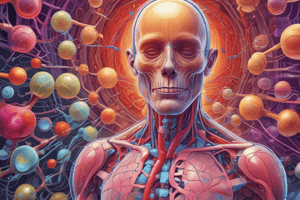Podcast
Questions and Answers
What is the primary function of the kidneys in maintaining body health?
What is the primary function of the kidneys in maintaining body health?
- Filtering blood without affecting any other body systems
- Only regulating water balance
- Producing urine only to remove waste
- Maintaining homeostasis by regulating pH, water, and electrolyte balance (correct)
Which of the following statements about the urethra is correct?
Which of the following statements about the urethra is correct?
- The urethra's length is identical for both males and females
- The urethra's location varies between males and females (correct)
- The urethra is only involved in urine production
- The urethra ends at the base of the bladder
How much urine is typically produced by renal processes each day?
How much urine is typically produced by renal processes each day?
- 0 to 0.5L
- 2.6 to 3.5L
- More than 3.5L
- 0.6 to 2.5L (correct)
What precautions should be taken when handling urine samples?
What precautions should be taken when handling urine samples?
What characteristic does normal urine possess?
What characteristic does normal urine possess?
What is the primary function of the urinary system?
What is the primary function of the urinary system?
Which of the following statements about the kidneys is true?
Which of the following statements about the kidneys is true?
Where do the kidneys extend from and to in the vertebral column?
Where do the kidneys extend from and to in the vertebral column?
What anatomical feature distinguishes the right kidney from the left kidney?
What anatomical feature distinguishes the right kidney from the left kidney?
In terms of histology, which aspect of urine formation is primarily influenced by osmolarity?
In terms of histology, which aspect of urine formation is primarily influenced by osmolarity?
Which structure surrounds each kidney, providing a protective layer?
Which structure surrounds each kidney, providing a protective layer?
What is the function of the perirenal fat?
What is the function of the perirenal fat?
What is the renal pelvis?
What is the renal pelvis?
What structure do the renal columns project into?
What structure do the renal columns project into?
Where do the ureters descend from the kidneys?
Where do the ureters descend from the kidneys?
What is formed when several minor calices unite?
What is formed when several minor calices unite?
What directs the bases of the renal pyramids in the kidney?
What directs the bases of the renal pyramids in the kidney?
How does the bladder position change when it is full?
How does the bladder position change when it is full?
What is uric acid primarily a byproduct of?
What is uric acid primarily a byproduct of?
Which physical characteristic does NOT typically indicate a healthy urine sample?
Which physical characteristic does NOT typically indicate a healthy urine sample?
Which of the following abnormal constituents in urine could indicate diabetes mellitus?
Which of the following abnormal constituents in urine could indicate diabetes mellitus?
What pH range is typically observed in healthy urine?
What pH range is typically observed in healthy urine?
What might a reading of low specific gravity (around 1.010) indicate?
What might a reading of low specific gravity (around 1.010) indicate?
What is the main purpose of measuring the specific gravity of urine?
What is the main purpose of measuring the specific gravity of urine?
Which abnormal urine constituent is a breakdown product of bile?
Which abnormal urine constituent is a breakdown product of bile?
Which of the following could be a symptom of hemolytic anemia based on urine analysis?
Which of the following could be a symptom of hemolytic anemia based on urine analysis?
What is the primary purpose of using dipsticks in the urine analysis method?
What is the primary purpose of using dipsticks in the urine analysis method?
What should be done with the urine after dipping the sticks for analysis?
What should be done with the urine after dipping the sticks for analysis?
Which of the following renal structures can be identified in kidney histology slides?
Which of the following renal structures can be identified in kidney histology slides?
What is the significance of the striated appearance in the kidney medulla?
What is the significance of the striated appearance in the kidney medulla?
What tissue layer of the bladder is characterized by transitional epithelium?
What tissue layer of the bladder is characterized by transitional epithelium?
During urine collection, how often should the measurements be recorded?
During urine collection, how often should the measurements be recorded?
Which components are required for the urine analysis procedure?
Which components are required for the urine analysis procedure?
What is the first step that subjects should take in the urine collection process?
What is the first step that subjects should take in the urine collection process?
Flashcards are hidden until you start studying
Study Notes
Renal Anatomy
- Kidney:
- Located retroperitoneally in the posterior abdominal region
- Right kidney is slightly lower than the left
- Left kidney is longer and more slender
- External features:
- Renal capsule: fibrous connective tissue surrounding the kidney
- Perirenal fat: adipose tissue cushioning the kidney
- Renal fascia: connective tissue anchoring the kidney to the abdominal wall
- Hilum: medial margin where renal artery, vein, lymphatics, nerves, and ureter enter/exit
- Internal features:
- Renal cortex: pale tissue surrounding the medulla
- Renal medulla: contains renal columns and renal pyramids
- Renal columns: extensions of the cortex dividing the medulla into pyramids
- Renal pyramids: triangular tissue with bases towards the cortex, apexes towards the renal sinus
- Renal papilla: apical projections of pyramids surrounded by minor calices
- Minor calices: several unite to form major calices
- Major calices: two or three unite to form the renal pelvis
- Renal pelvis: superior funnel-shaped end of the ureter
- Ureters:
- Muscular tubes transporting urine from kidneys to bladder
- Originate at the ureteropelvic junction
- Descend retroperitoneally along the medial aspect of the psoas major muscle
- Enter the pelvic cavity at the pelvic brim
- Bladder:
- Situated in the pelvic cavity when empty, expands superiorly into abdomen when full
- Urethra:
- Begins at the base of the bladder, ends with an external opening in the perineum
- Location differs between males and females
Renal Function
- Primary function of the urinary system is to maintain homeostasis by regulating blood composition and volume
- Regulates pH balance, water balance, and electrolyte balance
- Excretes waste products
- Produces 0.6 to 2.5L of urine daily
Urine Composition
- Organic substances:
- Urea: formed in the liver from ammonia and CO2
- Uric acid: end product of purine oxidation
- Creatinine: hydrated form of creatine
- Inorganic substances:
- Chloride, phosphates, sulfates, and ammonia
Urine Physical Characteristics
- Colour:
- Varies from light straw to amber
- Milky appearance can indicate pus, bacteria, fat
- Reddish colour can indicate urobilinogen
- Turbidity:
- Fresh urine should be transparent
- May become cloudy after standing
- Odour:
- Usually odourless
- Other characteristics:
- pH: usually 6 (range 4.8 – 7.5)
- Specific gravity: indicates the kidney's ability to concentrate urine
- High specific gravity can indicate a "wasting" process (e.g., cancer)
- Low specific gravity (1.010) can indicate severe renal damage
Abnormal Urine Constituents
- Glucose: warning sign of diabetes mellitus (sweet urine)
- Ketones: intermediary products of fat and protein metabolism. Ketonuria occurs in diabetes mellitus and during periods of stress
- Blood: may indicate high altitudes, kidney stones, etc.
- Hemoglobin: Hemoglobinuria may indicate hemolytic anemia, transfusion reactions, smallpox, malaria, hepatitis, renal infections, etc.
- Bilirubin: Breakdown product of bile. May indicate blocked bile ducts, cirrhosis of the liver, or liver cancer
- Protein: high molecular weight molecule usually not excreted. May indicate impairment of kidney functioning
Urinalysis
- Measures urine volume, clarity, color, specific gravity, and pH
- Dipsticks are used for analysis
- Perform urinalysis on own urine to stay safe
- Gloves should be worn when analyzing unknown samples
Practical Considerations
- Follow the instructions for urinalysis experiments to ensure safety
- Consume light breakfast 2 hours before the experiment
- No coffee/tea, only 1 glass of water (250ml) until the experiment begins
- Collect urine samples at intervals
- Analyze urine for volume, pH, specific gravity, color, and clarity
- Document results in a table
- Discuss findings
Histology
- Kidney:
- Identify the cortex, medulla (striated due to loop of Henle and collecting ducts), and glomeruli
- Bladder:
- Identify the mucosa layer with transitional epithelium and lamina propria
- Ureter:
- Identify the lumen, inner mucosa layer (comprising of transitional epithelium and lamina propria), and muscular layer (note longitudinal and circular muscle bands)
Studying That Suits You
Use AI to generate personalized quizzes and flashcards to suit your learning preferences.




